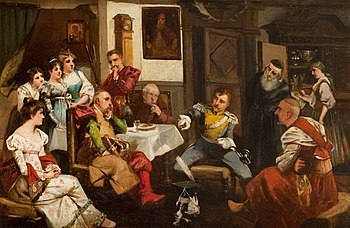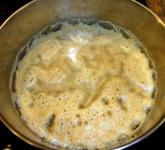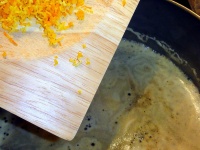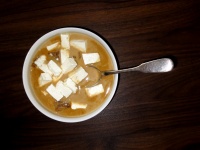Epic Cooking: Breakfast at Judge Soplica's
Pan Tadeusz is a heroicomic poem penned by Adam Mickiewicz (pronounced meets-KYEV-eetch), one of the greatest Polish poets that ever lived, in 1834. Even though it begins with the words "Lithuania, my country" and its only two entirely positive characters are a Jew and a Russian, the poem has somehow attained the cult status as Poland's national epic. Thanks, in part, to its mix of humour with nostalgia for the lost world of the Polish-Lithuanian civilization, which came to its demise during the poet's lifetime, and for the old way of life of the Polish-speaking Lithuanian gentry.
Some of this nostalgia shows in the depictions of food and drink; in fact, Pan Tadeusz may be seen as a great literary monument to Old Polish cuisine. Some of the dishes you can find in it – like bigos and zrazy – are still Polish favourites today; some other, like kontuza, arkas or blemas – had already been forgotten by Mickiewicz's times. It's also interesting to see what does not make an appearance in Pan Tadeusz; there's no mention here of such Polish classics as pierogi or gołąbki (if gołąbki are mentioned, it's in reference to pigeons raised for meat rather than stuffed cabbage leaves).
What is it about?
If you graduated from a Polish high school, then you are no doubt familiar with the poem. But if not, then let me give you a brief synopsis before we dive into the world of Old Polish food and drink. The epic is set in Soplicowo (pronounced sawp-leet-SAW-vaw), a fictional manor located in what is now Belarus, at the time of Napoleonic wars. Ostensibly, the main plot is a litigation over the ruins of an old castle. The story begins with the titular 20-year-old Pan (Lord) Tadeusz Soplica (pronounced tah-DEH-woosh sawp-LEET-sah) arriving at the house of his uncle, Judge Soplica, only to find it filled with the Judge's old lawyer friends who have all arrived for the dispute. The Judge, mind you, is not going to be a judge in this case; he's one of the litigants. Don't expect a courtroom drama, though; both sides of the dispute quickly resort to the tactics of faits accomplis, culminating in an all-out battle later in the storyline. Before it comes to this, however, Tadeusz, his uncle, the lawyers and even the Count – who is the other claimant – spend most of their time together on their favourite activities – hunting and gathering, eating and drinking.
The rythm of daily meals – breakfasts, dinners and suppers – form a framework for the sequence of events in the story. The numerous descriptions of dishes and beverages, farmlands and vegetable gardens, various gastronomic occasions, from vodka drinking in a tavern to opulent lordly banquets – allow us to get a pretty good idea about what was eaten and drunk in Soplicowo. So let's imagine we pay Judge Soplica a visit; what can we expect to be served?
The menu of the Soplicowo manor house – just like traditional Polish cuisine in general – is strictly seasonal. What you find on the table on a given day depends, firstly, on what is available in the particular season; plus whatever has been preserved from previous seasons by means of salting, smoking, pickling or candying. Secondly, this natural seasonality is overlaid by the Catholic liturgical cycle, with its sequence of feasting and fasting periods.
This is why it matters when exactly the plot of Pan Tadeusz takes place. The poem is divided into twelve books, or chapters. The plot of books I to X runs over the course of five days in the late summer of 1811 – from Tadeusz's arrival on Friday evening to (spoiler alert!) Father Worm's death on Tuesday night. We know the days of the week because on the third day, "after mass at the chapel, it was the Lord's Day, they [peasants] proceeded to Yankel's to drink and to play" (book IV, verses 221–222). Knowing that, on Monday night, "glow and glisten bright handfuls of moon-given gold" (VIII 608), we can check the phases of the moon in 1811 and calculate the exact dates: 30 August to 3 September. These dates also agree with the period when "a new guest, which not long [had been] perceived in the skies: [...] a mighty comet of first magnitude" (VIII 108–109), or the comet C/1811 F1, began to be easily visible from Earth. The plot then skips a few months and resumes in the spring of 1812. The last two books cover two days, the latter being "the most solemn day of Our Lady of Flowers" (XI 154–155), that is, the feast of Annunciation, which in 1812 fell on Saturday, 25 March.
The are enough references to alimentary customs in Pan Tadeusz for several blog posts; in this one, we're going to focus on breakfasts. A typical late-summer day in Soplicowo, especially if there were visitors, began with a hunt – a hare hunt, most often, and occasionally for some bigger game. The hunters were all men, who had to rise quite early in the morning for the occasion. The Sunday bear hunt began at 4:30 a.m., although this was probably exceptionally early; a bear hunt required more preparation than chasing hares, plus a holy mass had to be squeezed in before the hunt began. In any case, both Tadeusz and the Count liked to sleep in and were habitually late for the party.
Breakfast was consumed only after the hunt. In the case of a hare hunt – which took place closer to the manor house – the men would just return and join the ladies, who had started breaking fast before them. Unlike the more formal dinners and suppers, breakfast took the form of a casual buffet. People would eat standing or seating, without much attention to social hierarchy. The Judge grudgingly tolerated such novel habits. The men's Sunday breakfast, on the other hand, after the bear had been killed, was in the form of a picnic in the forest.
Soup
As the ladies began their breakfast earlier, let's first see what they were having.
Elder ladies, up earlier, had coffee before; |
| — Mickiewicz, Adam, Pan Tadeusz, or The Last Foray in Lithuania: A Tale of the Gentry during 1811-1812, translated by Marcel Weyland (all quotations from Pan Tadeusz come from the same translation), book II, verses 514–517 |
I've already promised a separate post about coffee and I haven't forgotten about it, but, for now, let's take a look at the other dish. Beer soup, known in Polish as gramatka or biermuszka (although neither name is used in Pan Tadeusz), now treated mostly as a historical curiosity, was once a popular breakfast dish, especially with women and children. According to some recipes, it should be served over diced dried twaróg, or farmer cheese. In Soplicowo there even was a special structure built for the purpose of drying it.
There then stood in the garden hard by the same fence [...] |
| — ibid., IX 679–689 |
Hors-d'œuvres
If we know by now what the women had for breakfast, then let's see what was served to the returning hunters. Their buffet, as you can guess, was way meatier.
For men there's a choice of smoked meats on a platter: |
| — ibid., II 518–521 |
The Polish names of these cold cuts, such as półgęski and kumpia, may sound obscure to the modern Polish ear, but the charcuterie itself would certainly satisfy today's most discerning meatarians. Półgęski, translated as "half-geese" in the passage above, are actually smoked goose breasts. Extremely popular in the past, they are now coming back into vogue. The Polish Ministry of Agriculture has declared them a traditional product of Kuyavia-Pomerania. The half-geese of Soplicowo, devoured entirely by the Dobrzyńskis during the foray, may have been cured according to the following late-18th-century recipe:
| Smoked half-geese are not bad, they may be eaten raw without any condiment. Cut a plump goose lengthwise in half. Lay one half on top of the other in a bowl, sprinkle with salt, saltpetre, ground juniper berries, black pepper, allspice and rosemary. Weigh down and let lie in it their own juice for a week. Remove, wrap each part in canvas or paper and smoke as you like. |
| — Kluk, Krzysztof, Zwierząt domowych i dzikich, osobliwie kraiowych, historii naturalney początki i gospodarstwo, Warszawa 1797, vol. II o Ptastwie, p. 153, own translation |
Kumpia, on the other hand, is simply a regional Polish term for smoked ham. Interestingly, it is the only pork dish found on Judge Soplica's table. As I've mentioned in my previous post, nobility was disgusted by all that grows or lives in dirt – and this includes pigs, which wallow and root in mud. Boars and piglets are mentioned in Pan Tadeusz much less often than cattle, sheep, rabbits or geese. Except for the best parts of the pig, carefully cured in smoke, pork was considered fit for consumption by peasants and Germans only. The conteptuous association between pork and Prussians may be also found in Pan Tadeusz, in Bartek Dobrzyński's account of the Greater Poland Uprising of 1794: "pound the landrat's neck, cut the hofrat's loin" (VII 50, own translation).
The following recipe for smoked ham comes from Kucharz doskonały (The Perfect Cook) by Wojciech Wielądko, the second oldest cookbook printed in Polish. Its title even makes an appearance in Pan Tadeusz, although the poet clearly confused this book with Stanisław Czerniecki's Compendium ferculorum, a cookbook older by a century!
| Make a marinade of salt, saltpetre and herbs, such as thyme, bay leaf, basil, garden balsam, marjoram and summer savoury, mixed with half part water, half part wine. Let this marinade rest for 24 hours, then drain and steep ham in it for 15 days. Afterwards, remove the ham, let drip-dry and hang in a chimney for smoking. Once cured, drain with wine and vinegar, and cover with ash for better preservation. |
| — Wielądko, Wojciech, Kucharz doskonały w wybornym guście z oszczędnością dogodny, Warszawa 1812, part I, pp. 117–118, own translation |
And finally, the smoked ox tongue. Princess Anna Jabłonowska née Sapieha, Palatiness of Bracław, recommended to prepare this delicacy in the following way:
| Take an ox tongue, salt it, cut off the thickest part, leave to cure in salt for 3 or 4 days, then hang in smoke as you would other things. |
| — [Jabłonowska], Ustawy powszechne dla dóbr moich rządców, vol. I, Warszawa 1786, quoted in: Dumanowski, Jarosław (ed.), Staropolskie przepisy kulinarne: Receptury rozproszone z XVI-XVIII w., Warszawa 2016, p. 89, own translation |
Simple, isn't it?
Pièce de résistance
So now that we've discussed the appetizers... What, did you think this was all?
At the end, as the last course, zrazy were served. |
| — Mickiewicz, op. cit., II 522–523 |
Before we get to what zrazy are, let's just say that this was a rather modest breakfast. The anonymous author of the Treaty on Breakfast published in the magazine Motyl (which also printed Mickiewicz's early poems) preferred a more substantial morning meal:
| Tasty culinary oeuvres, such as bigos, zrazy, cutlets, crêpes, vols-au-vent, roll-ups, brains, game and fruits make a light and nutritious breakfast. |
| — Traktat o śniadaniu, Motyl, issue 23, Warszawa, 8 August 1828, p. 66 |
Judge Soplica seems to have compensated for the lack of variety with quantity. Or maybe the zrazy of Soplicowo were so good, that once they showed up on the table, no one wanted to eat anything else? This might explain why, when two Russian army officers were invited for breakfast,...
Plut and Rykov so briskly set to cut and clink, |
| — Mickiewicz, op. cit., IX 250–253 |
Modern Polish readers tend to imagine that these were zrazy zawijane (pronounced ZRAH-zih zah-vee-YAH-neh), or Polish beef olives filled with mustard, onions, gherkins and mushrooms. Eating eleven of these per person would have been quite a challenge indeed! But, even though zrazy zawijane do pop up in Polish cookbooks of the time, they were not the rule. The word zrazy by itself referred simply to small fillets of thinly pounded meat or even to patties of finely chopped meat, which were fried and then drenched in some kind of sauce. It wan't necessarily beef either. Considering all the hare hunts in Soplicowo, these may have been hare zrazy just as well.
| Take two skinned hares, separate meat from bones, scrub off veins with a knife, then chop up finely and press through a sieve. Take beef suet, one third the amount of hare meat, clean, pound up in boiling water until it becomes like butter. Once the suet is warm, start adding the hare meat and keep pounding to achieve a smooth paste, with no suet visible. Add salt, some nutmeg, one egg and pound well again. [...] On a board, form round patties with a knife [...] Sprinkle with grated lemon zest and lemon juice, cover with buttered paper and, just before serving, fry on a small flame [on both sides]. Decorate with lemon slices and sauce [...] |
| — Szyttler, Jan, Kuchnia myśliwska, czyli Na łowach, Wilno 1845, p. 43–45 |
The above recipe comes from the first Polish cookbook devoted entirely to game dishes. Let's see what the author wrote about the sauce.
| Fry two tablespoons of finely chopped shallot or onion in a quarter of a pound of butter. Once the onion is soft, add one tablespoon of flour. Fry a little more, then stir in half a quart of good, clear stock. Add finely chopped lemon zest, bring to boil a few times, squeeze in lemon juice and sprinkle with pepper. Serve zrazy with this sauce. |
| — ibid., s. 43 |
And thuswise (more or less) was in the Judge's house breakfast observed.
Recipe
If anyone wishes to prepare a breakfast according to the recipes above, then good luck and enjoy! As for me, I don't eat meat, so I've decided to try an old recipe for the beer soup. Out of many available recipes, I've picked one from a how-to book by Mickiewicz's friend, Karolina Nakwaska née Potocka. It's close in time to when Pan Tadeusz was written and the ingredients (cream, cheese) all check out.
Ingredients:
- 1 bottle of beer
- 1/4 lb sugar
- rye bread
- farmer cheese
- 4 tbsp sour cream
- six yolks
- grated orange zest
- vanilla
| Pour a bottle of good, fresh beer into a pot; if it is strong, add water. If making for more than four persons, use more beer. Put on a flame. Add a quarter of a pound of sugar and grated orange zest. Dice equal amounts of rye bread and fresh farmer cheese and place in a vase. In a small pot, beat six yolks with four tablespoons of fresh sour cream. Remove from flame, stir in the eggs into beer (never add eggs over a flame, but pour into hot soup while stirring all the time). Pour boiling beer over the bread and cheese in the vase. If you dislike sugar, then don't add it to the beer, but serve on the side instead. Orange zest and vanilla give the beer a particularly good flavour. |
| — Nakwaska, Karolina, Dwór wiejski, Poznań 1843, vol. II, p. 24–25 |
Okay, but what kind of beer? That which was used to prepare a breakfast soup in the first half of the 19th century surely did not resemble today's lagers. The first golden-coloured lower-fermentation beer, similar to what you can now find on supermarket shelves all around the world, was only brewed in 1842, by Josef Groll in the Bohemian town of Pilsen. The hot beer served in Soplicowo was likely dark, cloudy and low in alcohol. It was probably seasoned with hops (which happened to be grown in Soplicowo), but less bitter than typical beers of today. Notwithstanding the variety of beer-soup recipes, one thing is certain: the dish was rather on the sweet side.
In my take on Nakwaska's recipe, I've decided to mix two different styles of beer: Baltic porter and wheat beer (in a ratio of 2:1). I also modified some of the proportions; for 1.5 litre of beer, I used only four yolks, about 150 g of sour cream and one tablespoon of sugar. Zest grated from a whole orange turned out to be overkill; a fourth of that would have probably sufficed. To this I added 250 g of half-fat twaróg, or farmer cheese (you may use skimmed, if you want), and four thin slices of fresh rye bread (but next time I would make it into croutons). I had no vanilla at home, so I used vanilla oil instead. It served easily at least four.
What was it like? Better than I had expected. The soup had a mellow, sweetish taste, with a flavour reminiscent of roasted-grain coffee substitute. The sweetness was broken with the mild bitterness of beer and orange zest, and tartness of the cheese, which also enhanced the soup's velvety mouthfeel. Leftovers were even better when reheated on the next day. I didn't measure the calorific value, but this is definitely a dish that will boost your energy at the start of the day.
| ◀️ Previous | 📜 List of posts | Next ▶️ |
| ⏮️ First | 🎲 Random post | Latest ⏭️ |








